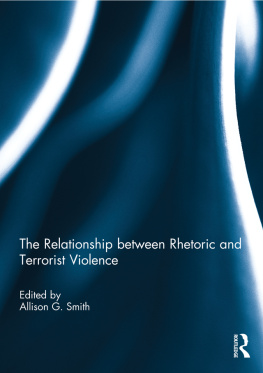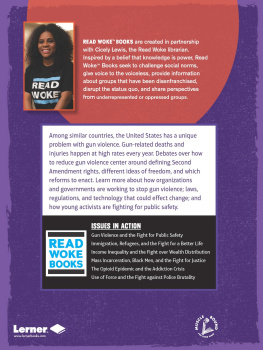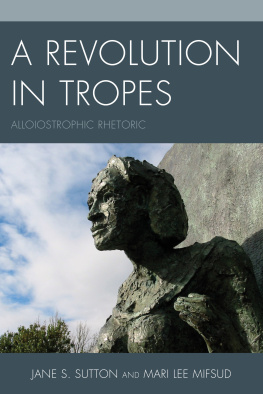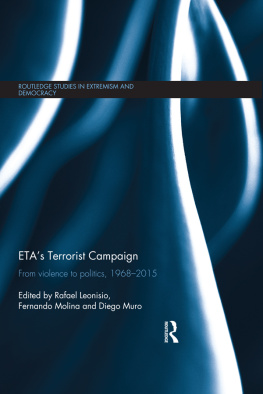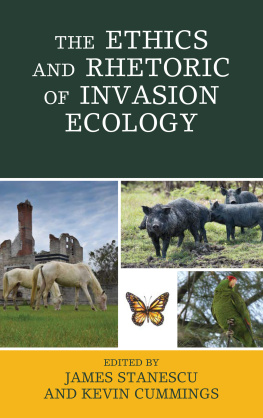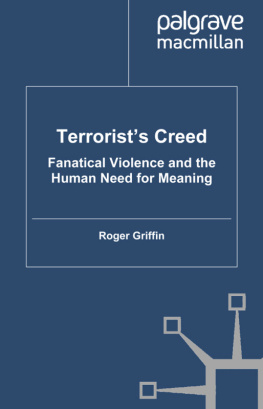Allison G. Smith - The Relationship Between Rhetoric and Terrorist Violence
Here you can read online Allison G. Smith - The Relationship Between Rhetoric and Terrorist Violence full text of the book (entire story) in english for free. Download pdf and epub, get meaning, cover and reviews about this ebook. year: 2013, publisher: Routledge, genre: Politics. Description of the work, (preface) as well as reviews are available. Best literature library LitArk.com created for fans of good reading and offers a wide selection of genres:
Romance novel
Science fiction
Adventure
Detective
Science
History
Home and family
Prose
Art
Politics
Computer
Non-fiction
Religion
Business
Children
Humor
Choose a favorite category and find really read worthwhile books. Enjoy immersion in the world of imagination, feel the emotions of the characters or learn something new for yourself, make an fascinating discovery.
- Book:The Relationship Between Rhetoric and Terrorist Violence
- Author:
- Publisher:Routledge
- Genre:
- Year:2013
- Rating:3 / 5
- Favourites:Add to favourites
- Your mark:
- 60
- 1
- 2
- 3
- 4
- 5
The Relationship Between Rhetoric and Terrorist Violence: summary, description and annotation
We offer to read an annotation, description, summary or preface (depends on what the author of the book "The Relationship Between Rhetoric and Terrorist Violence" wrote himself). If you haven't found the necessary information about the book — write in the comments, we will try to find it.
The Relationship Between Rhetoric and Terrorist Violence — read online for free the complete book (whole text) full work
Below is the text of the book, divided by pages. System saving the place of the last page read, allows you to conveniently read the book "The Relationship Between Rhetoric and Terrorist Violence" online for free, without having to search again every time where you left off. Put a bookmark, and you can go to the page where you finished reading at any time.
Font size:
Interval:
Bookmark:
Allison G. Smith

2 Park Square, Milton Park, Abingdon, Oxon, OX14 4RN
by Routledge
711 Third Avenue, New York, NY 10017
A catalogue record for this book is available from the British Library
by Taylor & Francis Books
The publisher would like to make readers aware that the chapters in this book may be referred to as articles as they are identical to the articles published in the special issue. The publisher accepts responsibility for any inconsistencies that may have arisen in the course of preparing this volume for print.
| Allison G. Smith |
| James W. Pennebaker |
| Antonio Sanfilippo, Liam McGrath and Paul Whitney |
| Roderick P. Hart and Colene J. Lind |
| Margaret G. Hermann and Azamat Sakiev |
| Stephen G. Walker |
| David G. Winter |
| Lucian Gideon Conway III, Laura Janelle Gornick, Shannon Houck, Kirsten Hands Towgood and Kathrene R. Conway |
| Peter Suedfeld and Jelena Brcic |
| Lucian Gideon Conway III and Kathrene R. Conway |
Science and Technology Directorate, Department of Homeland Security, Washington, DC, USA
Font size:
Interval:
Bookmark:
Similar books «The Relationship Between Rhetoric and Terrorist Violence»
Look at similar books to The Relationship Between Rhetoric and Terrorist Violence. We have selected literature similar in name and meaning in the hope of providing readers with more options to find new, interesting, not yet read works.
Discussion, reviews of the book The Relationship Between Rhetoric and Terrorist Violence and just readers' own opinions. Leave your comments, write what you think about the work, its meaning or the main characters. Specify what exactly you liked and what you didn't like, and why you think so.

